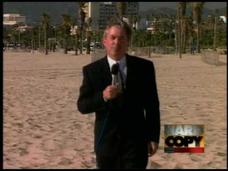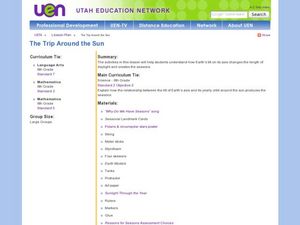Physics Girl
Should You Go to Mars? Ft. Bill Nye
Would you move to Mars? A video discussion explores the realities of traveling and living on Mars. Characteristics of the planet, its orbit, and revolutions provide key facts to help you make your decision.
Bill Nye
Bill Nye The Science Guy on Ocean Currents
Density drives the ocean currents. The difference in density is caused by the sun heating up the water and causing evaporation that leaves salt behind. The result? Thermohaline circulation! You could highlight this fine film in your...
Bill Nye
Bill Nye The Science Guy on Rocks and Soil
Rock the classroom with this hip video clip about dirt and rocks! Contents and the process of producing soil and sand are explained in the forest and on the beach. Time, pressure, and high temperatures are introduced as the requirements...
Bill Nye
Bill Nye The Science Guy on Evolution
Mr. Nye explains that living organisms change slowly over time. He uses the example of how humans have changed the environment for fish and emphasizes that fish cannot adapt as quickly as we are changing their habitats. A silly sci-fi...
Curated OER
The Science of Changing Seasons
Students explore basic principles of seasonal change, ponder the mechanisms that drive these changes, and perform experiments that show what causes the earth to heat differently during different seasons.
Bill Nye
Bill Nye The Science Guy on Pressure
Dive deep with air pressure as Bill shows how it keeps liquid from entering an upside down beaker when placed underwater. Then watch a rock music video about pressure. If you are putting together a PowerPoint on fluid pressure, you may...
Curated OER
Ocean Murals
Learners identify characteristics of water. They describe the process by which light decreases and pressure increases as water depth increases. They demonstrate the principle of water pressure in a small group experiment.
Curated OER
Barge Building: What Floats Your Boat?
Young scholars construct aluminum foil boats that float while holding the greatest number of pennies. They investigate the concept of water displacement, record their results, and watch a Bill Nye video on buoyancy.
Curated OER
Science: Safety Rules Videos
Young scholars examine and practice science laboratory safety rules. In groups, they discuss ways to illustrate the rules. Students plan and record videos demonstrating the safety rules.
Curated OER
Introduction to the Circulatory System
Fifth graders are introduced to the human circulatory system. After watching a Bill Nye video, they identify any misconceptions they had before watching it. They practice taking guided notes and discuss the video as a whole.
Curated OER
World of Protists
Students observe a jar of pond water and predict how much life they think exists in the jar and watch a "Bill Nye: The Science Guy" video regarding protists. They participate in an online virtual pond dip where they begin to familiarize...
Curated OER
The Trip Around the Sun
Sixth graders investigate the relationship between the tilt of the Earth's axis and the seasons. In this earth science lesson, 6th graders sing the song "Why Do We Have Seasons" and use simulate the Earth's tilt by using their bodies.
Curated OER
Science Detectives
Fifth graders examine the differences between chemical and physical changes. As a class, they are read a scenerio and determine whether it was deliberate act or not. In groups, they observe the changes of an alka-seltzer tablet and...
Curated OER
INSECTS AROUND US
Students identify characteristics of insects and if insects help or harm us. They describe the stages of metamorphosis.
Curated OER
Lakes and Ponds
Students describe and recognize the difference between a lake and a pond. They name six ways in which a lake or pond can be formed. They describe the importance and act of evaporation on a waterway.
Curated OER
Newton's Laws and Winter Sports
Young scholars investigate past winter Olympic games utilizing any skiing or snowboarding event to take Newton's Challenge. Helpful Web resources are provided and students enjoy learning science laws along with researching Olympic events.
Curated OER
SHARK BODY PARTS
Students list all the parts on the shark and label a diagram of the shark anatomy. They define the words, "gill and fin" and describe what they are used for.
Curated OER
Let it Grow!
Students explain the relationship of plants and animals in the environment. They name the basic requirements for plant growth and define the terms photosynthesis, stomata, chlorophyll and xylem.
Curated OER
Lord of the Rings - A Study of Tree Rings
Students examine trees and discuss how the environment effected the tree. They also predict what the area look like in fifty years.
Curated OER
Conduction, Convection and Radiation
Sixth graders listen to descriptions of types of heat to gain background knowledge For this heat lesson, 6th graders perform experiments to understand various types of heat transfer (convection, conduction and radiation.) Students assess...
Curated OER
Scrambled Eggs Anyone?
Students listen to Nursery Rhymes highlighting GRAVITY, pull ropes during a Rope Pull Activity and even drop eggs from a height during a Gravity Contest. This is a fantastic lesson which highly motivates Students!
Curated OER
I've Got That Sinking Feeling
Students design a simple boat and predict how much weight it can carry. They should also discover why objects float or sink and how this can be determined experimentally. A great lesson on buoyancy!
Curated OER
THE PHYSICS OF MOVING THINGS (AND NOT A MOMENTUM TOO SOON!)
Students list three examples of momentum found in their local environment; describe the importance of mass and velocity on momentum; and determine what is necessary to produce the greatest amount of momentum within a particular system.
Curated OER
Got Plants
Second graders discover that all living things need food in order to live. In groups, they examine the interconnectedness between animals and plants. They identify which animals eat plants to survive and which animals eat animals that...
Other popular searches
- Bill Nye the Science Guy #131
- Bill Nye the Science Guy #203
- Bill Nye the Science Guy 203
- Bill Nye the Science Guy 131

























